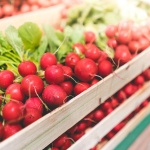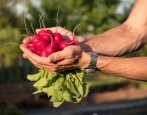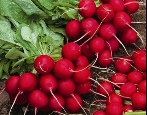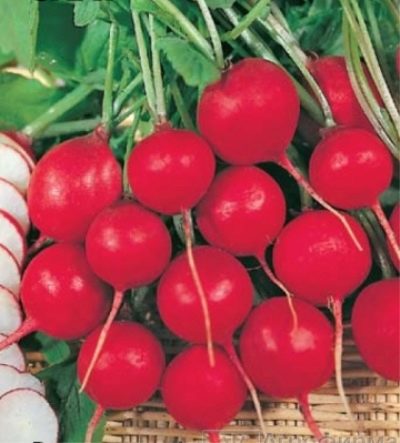
- Year of approval: 1971
- Ripening terms: early maturing
- Leaf rosette shape: sprawling
- The form: rounded
- Coloration: red-crimson
- Weight, g: 20-22
- Color of the pulp: white
- Pulp (consistency): juicy, crispy
- Taste qualities: excellent
- Average yield: 2.5-2.8 kg / m2
Among the many varieties of radish, there are old-timers, which are grown by both novice gardeners and farmers, as they are considered reliable, proven and productive varieties. These are the early ripening varieties Zarya, which quickly adapts to different climatic conditions.
Breeding history
Radish Zarya is familiar to many vegetable growers, since it has a long history. The vegetable was bred in the FNTS of vegetable growing by experienced breeders in 1965. After a series of variety trials, the vegetable crop in 1971 joined the ranks of the State Register of Breeding Achievements. It is recommended to grow a vegetable both in garden beds, and under film shelters, and in greenhouse structures, however, maximum productivity is observed when planting in open ground. A characteristic feature of the variety is the ability to grow in different climatic zones of Russia.
Description of the variety
Zarya is a plant with a spreading rosette of leaves of medium size: 22–25 cm. The rosette is formed by oval leaves with a medium dissection of bright green color. The leaf plates are covered with barely noticeable light pubescence. The petioles of the plant are thin, pale green. Roots are pulled out of the soil without much effort, despite the fact that during growth they do not rise above the soil surface.
Characteristics of the appearance of the plant and root crops
Zarya belongs to medium-sized varieties. The vegetables are evenly ripened, endowed with an attractive appearance, therefore they are in demand among farmers who grow crops for commercial purposes. The average weight of a radish is 20–22 g, and its diameter does not exceed 3–4.5 cm. The shape of the root crop is round or flat-round with an elongated axial root. An absolutely ripe vegetable has a uniform color: red-raspberry. The skin of the radish is very thin and delicate, with a smooth and shiny surface.
The harvested radish transports the transport over long distances. It should also be noted that vegetables can be stored for 10-14 days at a temperature not exceeding + 10 °. During storage, the roots do not wither, do not lose their taste and marketability.
Purpose and taste of tubers
Zarya wins over with its impeccable taste. The snow-white pulp is endowed with a dense, crispy, tender and juicy consistency without fiber and wateriness. The taste of the fruit is spicy, slightly sweet, without bitterness. The peel of the radish is also not bitter. The purpose of root vegetables is universal: they eat radishes fresh, add to vegetable salads, okroshka and cold soups.
Maturation
The variety is early maturing. From the moment of mass emergence of sprouts to ripe tubers, it takes only 18-24 days. The variety is characterized by a friendly return of the harvest, so you can pull out radishes from the garden at one time.
Yield
If you take care of the crop, it will surely thank you with a good and tasty harvest. On average, 2.5–2.8 kg of crunchy root crops can be harvested from 1 m 2 of plantings. In the open field, the yield indicator reaches 3 kg, and in greenhouses it is slightly lower: up to 2.2 kg.
Growing and care
The cultivar is cultivated by sowing seeds directly into the ground.Before planting, it is necessary to clean and fertilize the area, as well as prepare elongated grooves up to 2–3 cm deep. The distance between the rows should be at least 10–20 cm. The radish is planted according to the 10X5 cm scheme. After sowing, the beds are recommended to be covered with a layer of peat mulch, mixed with earth. The best period for sowing is considered April-May, when the air temperature has stabilized to + 15 ... + 18 °.
The agricultural technology of vegetable crops is based on standard procedures: timely irrigation with settled water, weeding and loosening of the soil, thinning 7-10 days after mass sprouting, top dressing 1 time, prevention of diseases and insect infestations.


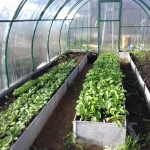
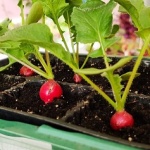
Soil requirements
Radish Zarya, like most of its relatives, grows productively on fluffy, nutritious, breathing, moist and non-acidic soils. It is advisable to choose a site with loose loamy or sandy loam soil. It is important that the soil is not waterlogged and heavy.
Required climatic conditions
Radish Zarya possesses good stress resistance. The culture is cold-resistant, easily tolerates small frosts and partial shade, and is also tolerant of a lack of moisture. It is recommended to grow a vegetable in a sunny area, where there is enough heat and light, and there is also protection from the cold wind.
Disease and pest resistance
The immunity of the variety is moderate, but it provides resistance to standard diseases. Sometimes the plants attack cruciferous fleas or aphids. Planting aromatic herbs or plants nearby, such as marigolds or dill, will help prevent the invasion of pests. It is worth noting that in extreme heat, radishes can begin to bloom without forming a fruit.

